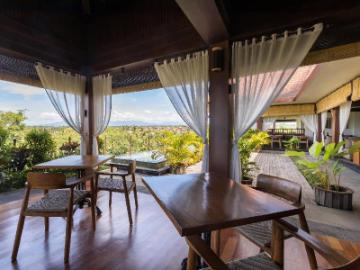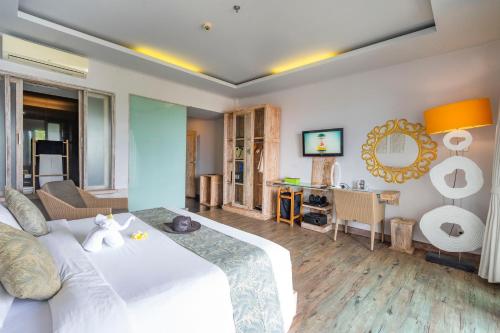Located just outside Ubud, Goa Gajah is a popular destination due to its impressive “Elephant Cave”, whose impressive and ornate doorway is a unique attraction in Bali. Though many are unimpressed with the temple complex beyond the main cave doorway, that’s because most don’t venture beyond the elephant cave to discover paths that go through a lush jungle garden with a cascading river, beautiful stone bridges and a scenic waterfall. Although we visited with somewhat low expectations, we were pleasantly surprised by this temple and the surrounding grounds. To help you plan your visit and get the most out of your time here, we put together this Temple Visiting Guide for Bali’s Pura Goa Gajah.
Disclosure: This page (Pura Goa Gajah – A Temple Visiting Guide) may contain product affiliate links. At no additional cost to you, we may receive a commission for purchases made through these links. More details can be found on our disclosure and policies page.
Planning a Trip to Bali?
You might be interested in these pages:
Best Things to See and Do in Ubud
Best Things to See and Do in Gili T
The Perfect Three-Week Bali Itinerary
Best Things to See and Do in East Bali
We also highly recommend these travel guidebooks:
Lonely Planet Bali, Lombok & Nusa Tenggara
Bali: The Solo Girl’s Travel Guide
Rough Guides: Bali and Lombok






Pura Goa Gajah: Temple Location & Map
Pura Goa Gajah is located just outside Ubud, in Bali’s Gianyar regency (link to Google Maps). There is a large car park right next to the temple.

How to get to Pura Goa Gajah
If you are staying in Ubud, Goa Gajah is technically within walking distance (5km, 1 hour), but the roads to get there aren’t ideal for walking and often don’t have sidewalks. Driving from Ubud town center will take you about 12-15 minutes.
Drive times from other areas in Bali can be highly variable depending on the traffic conditions.
Distance from Kuta: 40 km // Average Drive Time: 1h20 – 1h40
Distance from Canggu: 30 km // Average Drive Time: 1h10 – 1h30
Distance from Sanur: 25 km // Average Drive Time: 1h – 1h20
Distance from Sidemen: 30 km // Average Drive Time 1h – 1h20
In our opinion, the three best transport options to reach Pura Goa Gajah are: renting a scooter (moped), joining a group tour that hits several nearby attractions within a day or a half-day, or hiring a car and driver (which really isn’t as expensive as it sounds).
You can also use Bali ride-hailing apps such as Gojek or Grab, and make use of local taxis, but these options will typically cost more, especially if you plan on visiting several sites and attractions on the same day. Also, Gojek or Grab are not authorized to pick up people in certain locations where local taxi unions limit their services, including Canggu, Sanur, and Ubud. For more information on getting around the island and the different available options, check out our guide on How to Best Get Around Bali.
We highly recommend Airalo (eSIM card) for your connectivity needs when travelling abroad. Airalo is the world’s first and largest eSIM store with eSIM plans for 200+ countries and regions worldwide.
Getting to Pura Goa Gajah by Scooter: Once you get to Bali, you’ll quickly realize that scooter rental operators are everywhere. Although most street-side vendors will regularly be the cheapest option, they come short in several other aspects compared with more reliable and established vendors. For instance, most won’t offer roadside assistance or insurance that covers theft, nor do they regularly sanitize the helmets or have their scooters undergo regular maintenance. For this reason, we highly recommend using Bikago for your scooter rentals. Renting from them might be slightly more expensive (but still can be rented for as low as 12-15 US$/€ per day) but you get great peace of mind as among many other perks, all scooters undergo extensive quality checks.
What you get with your Bikago rental:
-Helmets
-Full tank of petrol and unlimited mileage
-Free Delivery and Collection at your Hotel
-24/7 Roadside Assistance and First Aid Medical Kit
-Charging Mobile Phone Holder
By Car and Driver hire: Hiring a car and driver to explore Bali can be a practical and cost-efficient way to experience a full day of sightseeing. Although this option is more expensive than renting a scooter (typically 40-60 US$/€ per day), you don’t have to worry about navigating the Bali roads and traffic. Also, most cars are modern and air-conditioned, which is welcome in Bali’s humid heat, and the local drivers always know the best routes to take and can optimize your ideal itinerary. Here are some of the best options to choose from:
By Group Tour: Group tours can be a great option to lower costs and reduce the hassle of having to plan an efficient itinerary. Their main downside is they might not exactly be tailored to your specific interests and preferences. But if you are mostly interested in hitting the main sights and attractions, there are these great tour options that can pick you up in multiple towns and visit places including Pura Goa Gajah:
Pura Goa Gajah – Temple Ticket Price and Operating Hours
Temple Entrance Fee
The Goa Gajah Temple entrance fee is 50,000 IDR per person (2025), which roughly amounts to 3 US$/€. This fee helps maintain the temple and its surrounding grounds.
Modest additional costs are required for parking: 2,000 IDR for scooters and 5,000 IDR for cars.
Having the exact change or small bills to pay for all costs is preferable as many temple sites don’t accept credit cards and they may not have enough change for large bills.
Temple Opening Hours
Pura Goa Gajah is open daily from 8 am to 6 pm.
Temple Facilities
Basic toilets are available on-site.
Temple Dress Code
As with all Balinese temples, it’s important to dress modestly and to ensure your shoulders and knees are covered. The entrance fee includes a sarong (a traditional wrap-around cloth) and sash (belt) rental if you don’t have your own.
It’s best to ignore touts/locals offering guiding services (unnecessary) near the entrance, and if someone asks your name, try to avoid giving it or when you exit the cave you might be presented with a ‘gift’ with your name on it and told you have to buy it.
About Pura Goa Gajah and its History
The exact origins of the cave are uncertain, but it is believed to have been built as a sanctuary for meditation and spiritual reflection. Archeological and historical experts believe Goa Gajah dates from the 11th century Bali Kingdom. The temple complex and the elephant cave reveal a fusion of Hindu and Buddhist influences, evident in its carvings, artifacts, and architectural styles. Also, the cave contains lingam and yoni, symbols of Shiva, and the image of Ganesha, while by the river there are carved images of stupas and chattra, imagery of Buddhism.
Goa Gajah translates to “elephant cave” in English. Despite its name, the temple is not wide enough to fit an elephant inside, and there aren’t any elephant markings here except for a big contemporary statue near the parking lot entrance (in fact, there were never any elephants in Bali until recent tourist attractions changed that). The origin of the name is unclear. Some say it was named so when a Dutch official found in the cave the statue of the elephant-headed god Ganesha. Another theory is that the name derives from “Lwa Gajah”, which in ancient Javanese roughly translates to “Buddhist monastery on the banks of the river”.
Surprisingly, the elephant cave was lost in the jungle for centuries until it was rediscovered by Dutch archeologists in 1923. The full extent of the site, including the fountains and the bathing pools, wasn’t discovered until 1964.
The Goa Gajah site was added to the UNESCO World Heritage Tentative List in October of 1995 but was pulled out along with a dozen other sites in 2015 by the Balinese government, on behalf of the Balinese people who wanted the temple to remain a place of worship first and foremost and not turn into a global tourist attraction.
Pura Goa Gajah – What to Expect
From the car park, you’ll first descend a lengthy staircase that quickly opens up onto the spacious temple complex, where you will notice two large square bathing pools, each of which has waterspouts held by six female figures. These pools were used for ritual cleansing and their design reflects the importance of water in Hindu rituals, symbolizing purity and renewal.







Across from the pools is the famous Elephant Cave, which is characterized by menacing faces carved into the stone, believed to ward off evil spirits. The primary figure is a giant face with a gaping mouth, representing the entrance to the underworld.
The inside of the cave is a little disappointing. It’s a small t-shaped shaped tunnel, with niches carved into the walls that house statues of Hindu deities. The dimly lit space creates an intimate setting for prayer and meditation and is often filled with the smoke of incense burning.





Beyond the cave, there are a few other shrines, but they pale in comparison to what lies south of the temple complex. A short but steep staircase takes you down into the jungle where beautifully manicured gardens and moss-covered stone bridges await. This section is built within a ravine where the Petanu River flows, and it’s a lovely place to enjoy a quiet stroll and even admire a small waterfall.











Why You Should Visit Pura Goa Gajah
– Ancient Temple Complex: Some of the structures (including the cave) are some of the oldest in Bali.
– Beautiful Jungle Gardens: This was probably our favorite part of the visit to Goa Gajah.
– Easy to Get there from Ubud: Easy to add to any day trip either from or to Ubud, either on your way in or out of town.
Why You Might Not Want To Visit
– The Elephant Cave can be disappointing: Although the exterior is interesting and a beautiful work of art, the interior is somewhat of a letdown.
– Few Temple Structures: compared to other Balinese temples, there is less “temple” to see here. However, we do think the beautiful gardens make up for this slight disappointment.
How Long Do You Need at Goa Gajah
Goa Gajah is not a very large temple complex, but if you want to spend some time strolling through the garden section, you should plan to stick around 20-30 minutes.
Best Time to Visit Pura Goa Gajah
Best Time of the Year
Although we visited during the dry season, there’s no bad time of year to visit the temple. There’s a higher risk of rain during the wet season (November-April), but that shouldn’t discourage you as there are likely to be fewer other tourists around.
Consider off-peak months like May-June or September-October for a more personal experience with fewer crowds.
Best Time of Day
Goa Gajah can get crowded given its proximity to Ubud and popularity with tour buses. It’s generally best to visit early in the morning or late in the afternoon to experience the temple and the gardens with fewer crowds.
Other Nearby Temples
There are several other temples in the immediate vicinity of Pura Goa Gajah, including Pura Samuan Tiga (link to Google Maps), Pura Pusering Jagat, and Pura Penataran Sasih, all of which are less than 5-minute drive away. Unfortunately, we didn’t get to visit these temples, so we can’t comment on them much other than to say that we wanted to visit them but we were never able to fit them into our schedule during our time in Ubud.
The nearest temples we visited are located near the center of Ubud, including Pura Gunung Lebah, Pura Taman Kemuda Saraswati, and Ubud Palace, all of which we describe (among others) in our guide on the Best Temples to See In and Around Ubud.
To discover more of Bali’s temples outside of Ubud, be sure to check out our guide on Bali’s Best Temples to Visit.
Ubud Monkey Forest
Other Sights and Attractions near Pura Goa Gajah
Roughly midway between Ubud’s center and Goa Gajah is the famous Ubud Monkey Forest, which was one of our favorite attractions to visit around town.
Heading east from Goa Gajah you’ll quickly reach Kampo Lampo Waterfalls, and from there, you won’t be too far from several waterfalls including Taman Sari, Tibumana, and Suwat waterfall.
For a more complete list of attractions that you can visit from Ubud, check out our guide on the Best Day Trips from Ubud.
Where to Stay Near Pura Goa Gajah
In our opinion, the best place to stay is in Ubud, whose location makes it a great base from which to explore several nearby temples including Pura Goa Gajah. All of the following are some of the best mid-range hotel accommodations located within walking distance from the city center:
Komaneka at Rasa Sayang Ubud Hotel
















Planning a Trip to Bali?
You might be interested in these pages:
Best Things to See and Do in Ubud
Best Things to See and Do in Gili T
The Perfect Three-Week Bali Itinerary
Best Things to See and Do in East Bali
We also highly recommend these travel guidebooks:
Lonely Planet Bali, Lombok & Nusa Tenggara
Bali: The Solo Girl’s Travel Guide
Rough Guides: Bali and Lombok
Photography Gear
If you like our photography, you might be interested in some of the gear we use to shoot our travel and hiking destinations.
Camera Body – Nikon Z 6ii Fx-series Mirrorless Body
Main Lens – NIKON 24-120mm F/4G ED VR AF-S
Zoom Lens – Sigma 745-306 150-600mm f/5-6.3
Polarizing filters – Urth Circular Polarizing (CPL)
Camera Tripod – K&F Concept 64-inch Camera Tripod
Mini-tripod – Lammcou Flexible Camera Tripod
Camera/hiking backpack – Vanguard Alta Rise 48 Backpack
Universal Travel Adapter – VYLEE Universal International Power Travel Plug
Other Travel Essentials
Travel Insurance
SafetyWing is a travel insurance company that offers comprehensive coverage for travellers. Includes Medical Insurance and Travel Insurance. Primarily geared towards long-term travellers, digital nomads, and expats.
e-Sim cards
Airalo is the world’s first and largest eSIM store with eSIM plans for 200+ countries and regions worldwide. With Airalo eSIMs, travellers can get connected the moment they land at their destination and avoid nasty data roaming charges
eSIMS are a sustainable alternative to single-use SIM cards – they are 100% digital, require less energy to produce and be re-used rather than disposed of.
Car Rentals
Discover Cars is our go-to website for car rentals. We almost always find our preferred rate there.
Transfer from Airport
Welcome Pickups is our favourite private transfer service, which you can pre-book at a fixed price. Currently available in 220 cities all over the world (mostly in Europe, but with several major cities in Asia, the Middle East and the US).
Kiwitaxi is another private transfer service – we haven’t tried it yet, but it’s currently available in a few more countries (102 as of 2024).
Hotels and Accommodations (coming soon)
Photography Prints
If you found this blog useful, you can help support our blog by purchasing low-cost digital prints. Printed physical prints are also available for purchase.








—–
Well, that wraps it up! We hope you enjoyed our travel guide on Bali’s Pura Goa Gajah and that it will prove useful for planning your trip.
—–
You might also be interested in these related pages:




















